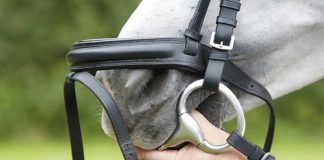There are lots of reasons why horses refuse or run out when jumping. A horse might be inexperienced and simply can’t figure out how to jump a fence with a person sitting on his back. Most horses know how to jump naturally; you may have seen a horse pop over a log in his field. But clearing a fence with a rider in the saddle is more difficult.
Horses must be taught how to jump gradually to build up their confidence. They need to start over poles and tiny fences before they move on to bigger, wider fences.
It’s important that a rider feels brave when jumping too. If you’re nervous, your horse will feel it. If you’re thinking, “I don’t really want to jump that fence,” it’s likely your horse isn’t going to want to jump it either!

If you’re just learning how to jump, stick to small fences at first and work your way up to bigger fences and jumping courses. Take regular lessons with an experienced trainer so that you become a capable jumper and learn how to ride your horse effectively around a course.
Here are some exercises that will help your horse become more confident when jumping.
Get Over It!
Keep the fences small at first so that if your horse refuses a fence, you can ask him to jump it from a standstill. He should always think “forward,” not “turn around and try again.”
If you’re going to give your horse a tap with your crop to encourage him forward, tap him behind your leg. His impulsion comes from his rear end, not his front end, so there’s not much point in tapping him on his shoulder.

Placing Pole
A placing pole helps your horse take off at the correct spot so that he’ll jump more smoothly. Place a pole about 9 feet, or three human strides, from the base of a cross-rail or vertical fence.
Always trot into a fence with a placing pole—it’s OK to canter after you land. Do rising trot until you’re almost at the pole, and then get up into jumping position.
Stay off your horse’s back when he’s jumping. If you bounce around in the saddle while he’s trying to clear a fence, he’s not going to want to jump again. Grab some mane, push down your heels and keep your body as quiet as you can over the fence.
Holding mane also stops you from yanking on your horse’s mouth if you get left behind or jostled in the saddle. A horse gets confused when you pull on his mouth in front of a jump. He thinks, “Does she want me to stop?”
Introduce Different Fillers
While jumping smaller jumps, mix it up by adding different fillers so that your horse gets used to jumping whatever is in front of him—even if it looks a bit strange! Fillers are objects placed under a jump pole to make the fence seem solid. Fillers can be flower pots, buckets, brush boxes or a blanket hung over the top rail.

Build a Chute
If your horse likes to run out to the left or right of a fence sometimes, make a 2-foot-wide chute out of two poles in front of the fence. As you approach the fence at a trot or a canter, steer your horse to the middle of the chute, keep an even hold on the reins, and kick on. A chute is like a path that leads your horse to the middle of the fence.
Make a V
To discourage runouts, place two poles so that they rest on the jump and form wings out to the sides. These poles help you keep your horse aimed at the middle of the fence.
If your horse spooks at the poles, encourage him forward with your voice and crop if needed. If the fence is small, he should be able to jump it from a walk. It’s important to get him over the fence without backing up or turning around and trying again.
If your horse jumps the fence nicely a few times, remove the poles.
Back to Basics
If your horse has stopped several times in front of a fence, ask your trainer to lower the fence and try jumping it again. If your horse jumps the smaller fence nicely twice, put up the fence and try again.
Open the Rein
Sometimes you have to really steer your horse to a fence, and it might not win you equitation ribbons—especially if the horse is inexperienced and is wiggling in front of a fence.
If your horse starts to veer to the left in front of the fence, open up your right rein by moving your hand out to the right to pull him over a bit so that he’s aiming for the middle of the fence. Use your left leg to push him over into the right rein.
When your horse is aiming toward the middle of the fence again, bring your hand back to his neck and keep both hands still as you pop over the fence.
Thanks to Meadow Lake Equestrian Center in Lancaster, Ky., for letting us take pictures on the farm. www.meadowlakeec.com
This article originally appeared in the January/February 2014 issue of Young Rider magazine. Click here to subscribe!






